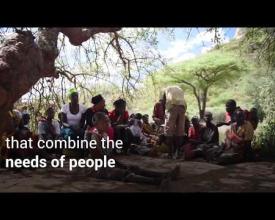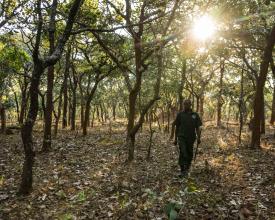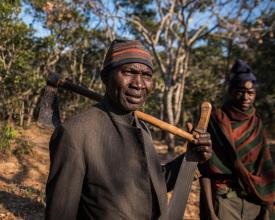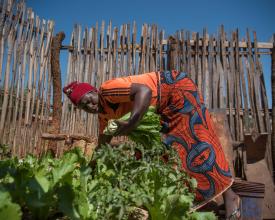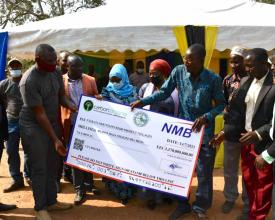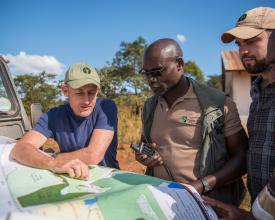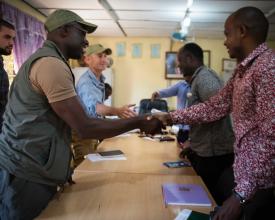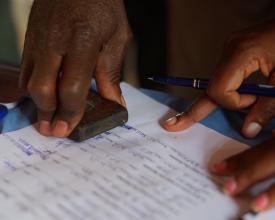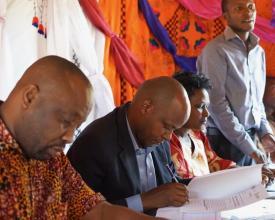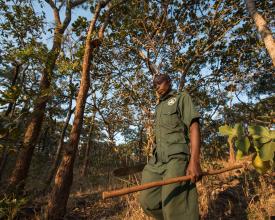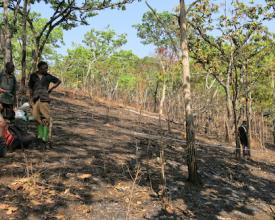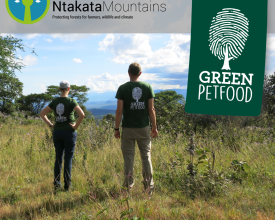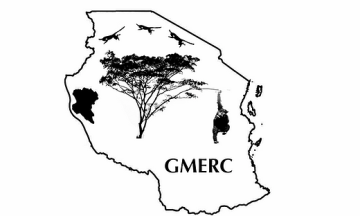
Ntakata Mountains Project – A natural climate solution financed by the voluntary carbon market that benefits both people and biodiversity.PATHFINDER AWARD 2021 WINNER
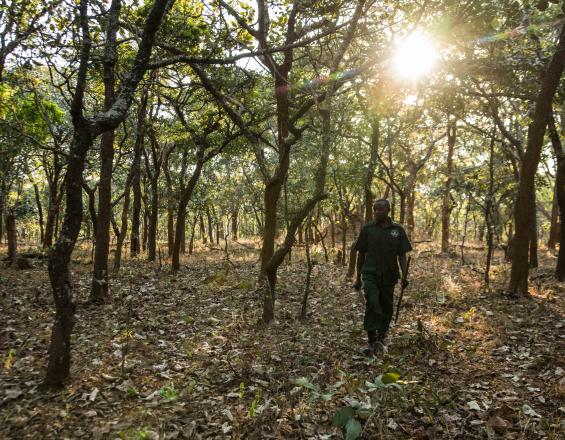
The Ntakata Mountains Project is a natural climate solution that protects 216, 944ha of threatened, community owned forests. Using the REDD (Reduced Emissions from Deforestation and forest Degradation) monitoring framework and methodology for carbon accounting, eight forest communities keep 1,200,000 trees standing, avoiding 550,000 tonnes of CO2 emissions annually. The resulting carbon credits are certified by VERRA’s VCS and CCBA standard and sold on the international voluntary carbon market earning the communities US$581,650 since the project’s first issuance of credits in 2020. Securing indigenously managed forests is critical to climate mitigation and biodiversity conservation efforts.
Context
Challenges addressed
Environmental Challenge:
Deforestation & land use change contributes to approx. one quarter of the world’s man-made greenhouse gas emissions while in Tanzania it contributes to approx. 70% of national GHGs. The key threat to the forest is shifting agriculture. In addition, grazing by pastoralists, mining, and the development of new infrastructure, negatively impact the forest, with consequences for water, livelihoods & conservation.
Social Challenge:
Undefined land use plans and boundaries were making it difficult for community members to defend and protect their forest leading to conflict.
Economic challenge:
There are few economic opportunities available in the Ntakata Mountains, the majority of which depend on healthy forest ecosystems. The people farm small family plots, harvest honey and wood. The REDD project creates an additional revenue stream that keeps the forest intact, enhancing the forests’ ability to provide essential ecosystem services.
Location
Process
Summary of the process
The five building blocks are interlinked and must be implemented in the following order.
1.Collaboration with landscape partners brings the necessary expertise to the project.
2. Legal contracts between resource owning communities and Carbon Tanzania form the basis of a long-term working relationship and solidifies the agreement of the partnership leading to the commencement of project development.
3. Project development begins with participatory land use management & the development of land use plans, which can only happen once relationships and contracts have been formed. Demarcating boundaries of the Village Land Forest Reserves helps to raise awareness of the project preventing conflict, which upholds contracts.
4. The development of a results-based payments for conservation using a REDD methodology can happen once the previous 3 steps have been undertaken. Following initial verification, certified carbon credits are issued.
5. Accessing the voluntary carbon market can only begin once the project has been certified.
Building Blocks
Land Use plans including the delineation of Village Land Forest Reserves & Participatory land use management.
Indigenous people are the most effective stewards of forest ecosystems, and the success of the Ntakata Mountains REDD project can be directly attributed to the involvement of the forest communities who live in and depend on the forests for their livelihoods. By working with indigenous peoples and forest communities who legally own and manage their natural resources we can ensure they directly benefit from both the protection of their natural resources and the carbon finance that is generated through the project’s activities.
Land use plans that are determined and demarcated by community members increases local awareness and reduces conflict.
Local resource owners are directly involved in the development of the Ntakata Mountains REDD project from the beginning with introductory meetings with the project villages and communities that focus on free, prior, and informed consent (FPIC). Participatory land use management then begins with the communities determining how their land use plans will be zoned and agreeing on boundaries. Once all community members agree to the established land use plans, the boundaries of the Village Land Forest Reserves are then demarcated to facilitate protection.
Enabling factors
The forest communities at the heart of the project must have legal ownership and management rights over their natural resources with clearly defined boundaries.
Lesson learned
One of the most important lessons learnt from the development of the REDD project is that once indigenous and forest peoples have the legal rights and associated land tenure over their natural resources, and once the tools to implement forest protection activities have been collaboratively developed, the forest is effectively protected.
Collaboration with landscape partners including Village and District governments, TNC and Pathfinder International (Tuungane).
Collaborating and co-operating with local governments and organisations who share a common vision and common goals, yields enhanced results with greater efficiency, both in terms of resources used and funds deployed.
The first step is to identify partners with common goals but with varying strengths to achieve enhanced results. Time then needs to be taken to meet regularly, whereby relationships are developed and nurtured, to gain a deeper understanding of individual needs and to review and update procedures to ensure resources are shared and that strengths are being maximized.
Enabling factors
A shared understanding of the importance of forest community land rights, the development and promotion of good governance, and respect for community development priorities is critical for successful collaboration.
Lesson learned
The process of collaborating with landscape partners and local government institutions demands a long term approach in order to build genuine trust and mutual understanding. Our relationships with our local partners have generally been positive and mutually beneficial, but we have learned that continued efforts need to be made to ensure that alignment of goals and values is maintained across institutions as it can be challenging for new personnel in the respective organisations to immediately embrace the historical relationships between partners.
Legal contracts between resource owning communities and Carbon Tanzania
REDD projects require long term commitments between the forest-owning communities and the project developer in order to deliver genuine, high integrity carbon credits that avoid emissions through reduce deforestation while improving livelihoods and protecting biodiversity. Contracts guarantee that both parties are aware of this long-term commitment and of each parties’ responsibilities.
The contract between the forest communities of the Ntakata Mountains and Carbon Tanzania, the project developer is 30 years. This includes the two years it takes to develop and certify the REDD project. Before contracts are signed Carbon Tanzania conduct introductory meetings with community members that focus on free, prior and informed consent (FPIC) to ensure the rights of the communities are upheld during the development of the contract.
Enabling factors
Many laws & regulations in Tanzania are designed to allow for localised ownership & management of resources and affairs. This is enshrined in the Village Land Act 1999, the Forest Act 2002 and the Local Government Act 1982 on which the Ntakata Mountains project is founded. These acts form the foundations of the contract that guides project activities and responsibilities, making it clear that the villages and the District have complete agency over their by-law enforcement, forest protection and financial management systems.
Lesson learned
The existence of laws does not always guarantee that they become part of local government or community life and business, so we have learned that the process of implementing project activities with the associated need for all stakeholders to understand their rights and the law is the best way to make legal requirements real. We have worked with all stakeholders through various processes of education, training and facilitation to both understand the legal position, but to also understand the practical actions required to fulfil obligations of the law.
A results-based payments for conservation system measured and monitored using a REDD (avoided deforestation) project methodology.
REDD (Reduced Emissions from Deforestation and forest Degradation) projects can link sustainable management of biodiverse forests to economic and livelihood improvements. Using the REDD monitoring framework and methodology for carbon accounting, the forest communities of the Ntakata Mountains are empowered to earn carbon revenues through achieving reduced deforestation rates in the wildlife-rich forests of western Tanzania.
Once a REDD project has been developed and verified it must undergo regular certification to prove that deforestation has reduced and that the resulting carbon credits are real, measurable, permanent and additional. Without certification the carbon credits cannot be sold, putting an end to this revenue stream.
Enabling factors
Ownership of the project by the forest communities conducting the forest protection activities is critical to the success of the results-based REDD project.
A team dedicated to the lengthy development and certification process of the REDD project and commitment from the forest communities to uphold their responsibilities for the duration of the contract is fundamental to the success of the project.
Lesson learned
Transparency and mutual accountability between project developer and the communities is imperative throughout the development of the project and throughout the execution of project activities.
Accessing the voluntary carbon market.
Access to the voluntary carbon market provides unconditional finance allowing the communities to earn revenue from the protection of their natural resources. Earned revenue results in increased ownership over the project and empowers forest communities to determine how that revenue will best be spent to improve forest protection activities and enhance community development in a way the serves the entire community.
Carbon Tanzania is the project developer who connects the forest communities to the international voluntary carbon market by sourcing clients, organizing verification and registering the certified carbon credits on the respective environmental registries.
Enabling factors
For carbon credits to be sold on the international voluntary carbon market they must first be verified by an international third-party certification standard. The Ntakata Mountains project is certified by VERRA’s VCS and CCBA standard.
Access to market must also be established. Carbon Tanzania has an established network within the voluntary carbon market enabling the sale of the certified carbon credits.
Lesson learned
Clients purchasing carbon credits need to have genuine carbon reduction strategies to uphold the legitimacy of the project generating the certified carbon credits.
Most clients will also have their own certification and CSR requirements that can determine which certification standard they need their credits to be verified by.
Impacts
The project benefits 38,000 people who live in & depend on healthy forests to provide ecosystem services necessary for a farming lifestyle. The people have earned US$581,650.00 through protecting their community owned forests. This revenue empowers the communities to determine their own developmental needs. They receive the revenue bi-annually & as a community determine how to allocate the revenue - usually to the community health fund, to building infrastructure to improve educational opportunities, to fund the Village Game Scouts (VGS) and other forest protection activities, to develop economic opportunities and to fund other community development needs as they arise.
The carbon credits represent avoided emissions that would be released should the forests be cut down. The credits are sold on the voluntary carbon market to organisations who are offsetting their unavoidable emissions, further mitigating climate change.
The forests provide habitat for 12 endangered species including the largest population of Eastern Robust Chimpanzee. Through the VGS, the community are recording the location & age of chimp nests and submitting the data to the Greater Mahale Ecosystem Researchand Conservation Centre (GMERC) in a bid to further the understanding of chimpanzees across the global community.
Beneficiaries
8 communities totaling 36,000 people are engaged in the REDD project & are responsible for the daily operations - it is these people who are the beneficiaries of the environmental and economic outputs.
Sustainable Development Goals
Story

Frank Kweka is a young man who grew up in a rural village in the Ntakata Mountains and developed a deep understanding of his environment while participating in the Jane Goodall Institute’s Roots & Shoots program. Throughout his early years and into early adulthood, he developed a growing awareness of the negative impact humans were having on the forests that surrounded him and decided to study conservation, earning a bachelor’s degree in environmental studies at the University of Dar es Salaam. Upon returning to the Ntakata Mountains he secured a short-term contract as the assistant at the Natural Resource Department at Tanganyika District Council for the Environment. When his contract ended, he continued to volunteer for multiple years to satisfy his passion while farming a small half acre plot to support his family.
While volunteering, he witnessed a high turnover of people coming from Dar es Salaam and other urban areas to fill jobs in the environmental sector in the Ntakata Mountains. After a short time the visitors would leave having invested little into the area Frank had always called home.
When Carbon Tanzania identified the need to employ a Project Manager they were determined that the success of the project lay in having a community member fill this role. Frank’s experience and passion was quickly recognized, and he was recruited for the role in 2019. In the last 2 years Frank’s commitment to the project has been a driving force for its success with the Ntakata Mountains project now one of the most impactful and respected projects in the area.
Frank’s experience and relationship with his previous employees in the District Office ensure the project runs both smoothly and effectively.
Frank’s connection to his community runs deep, which enables him to see how the project can best serve the needs of all community members. Frank’s input has resulted in securing health insurance for over 36,000 members of his community, in revenue being spent equitably across the eight villages to develop educational resources and establishing initiatives such as the Community Conservation Bank (Cocoba), a microfinance initiative designed to teach women to open small, environmentally-friendly businesses. Frank’s guidance ensures the community members are empowered to determine their own developmental needs while developing a deeper understanding of the need for healthy intact forests.
